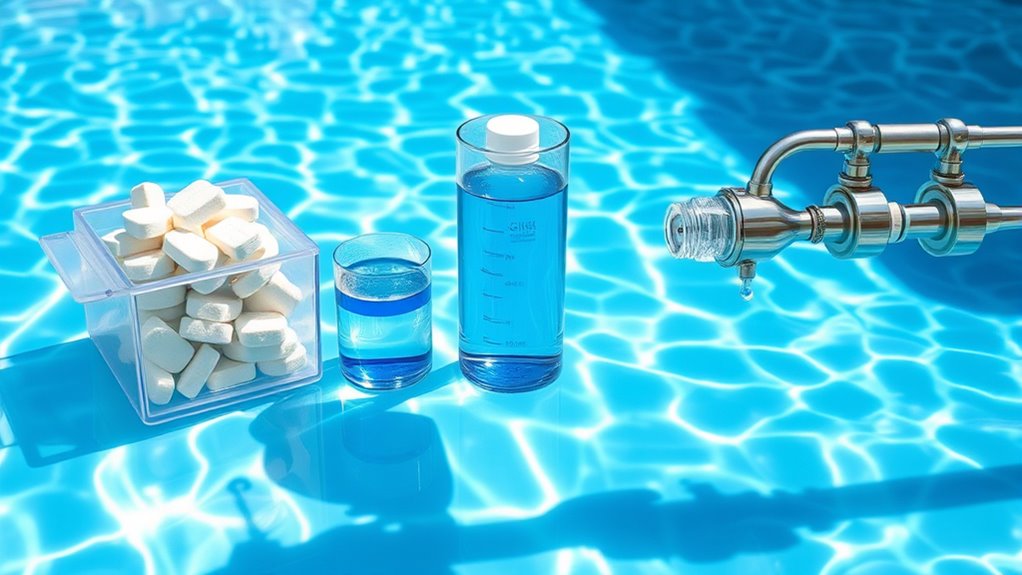Chlorination methods like tablets, liquid solutions, and saltwater systems each provide effective ways to disinfect water. Tablets are convenient for small-scale use and easy to store, while liquid chlorine allows precise dosing for larger volumes. Saltwater systems generate chlorine on-site through electrolysis, offering a continuous and chemical-free option. Understanding these methods helps you choose the right approach for your needs. Keep exploring to discover how each method can best protect your water supply.
Key Takeaways
- Chlorine tablets are portable, easy to use, and ideal for small-scale or emergency water disinfection.
- Liquid chlorine solutions allow precise dosing and are suitable for treating large water volumes quickly.
- Saltwater systems generate chlorine on-site through electrolysis, providing continuous disinfection without chemical handling.
- Proper dosage, contact time, and handling are essential for each method’s safety and effectiveness.
- Each chlorination method offers specific advantages tailored to different water treatment needs and settings.

Chlorination methods are essential for disinfecting water and ensuring its safety for consumption and use. When you’re considering how to treat water effectively, understanding different disinfection processes and water treatment techniques can help you choose the right method for your needs. Chlorine remains one of the most reliable disinfectants because it kills bacteria, viruses, and other pathogens efficiently. Whether you’re managing a community water system or treating water at home, knowing the options available will allow you to make informed decisions.
Chlorine is a reliable disinfectant for safe, effective water treatment at home or in communities.
One popular disinfection process involves using chlorine tablets. These tablets are convenient and easy to store, making them ideal for emergency kits, camping, or small-scale water treatment. You simply drop a tablet into water, wait for it to dissolve, and then allow sufficient contact time for the chlorine to disinfect the water properly. This method is straightforward, cost-effective, and doesn’t require specialized equipment. However, it’s essential to follow the recommended dosage and wait times to guarantee the water is safe to drink. Chlorine tablets are particularly useful because they provide a controlled release of disinfectant and can be used in various settings, from households to field operations.
Liquid chlorine solutions are another common form of water treatment. These liquids are often used in municipal water supplies but are also suitable for home use if you have access to a stable and properly diluted product. Liquid chlorine offers the advantage of precise dosing, which allows you to adjust the amount based on the volume of water you’re treating. You’ll add a specific number of drops or milliliters to your water, then stir and wait for the disinfectant to take effect. This method is efficient for treating larger volumes of water and provides rapid disinfection when used correctly. It’s important to handle liquid chlorine carefully, as it’s a strong chemical that can cause irritation or damage if not used with proper precautions.
Saltwater systems, also known as salt chlorination, are a more advanced water treatment technique often used in swimming pools, but they are increasingly popular for household water systems as well. These systems generate chlorine on-site through electrolysis of salt, creating a continuous supply of disinfectant without the need for adding chemical chlorine directly. Saltwater systems are appealing because they produce a more stable form of chlorine, reduce chemical handling, and can lower long-term costs. If you’re considering this method, you’ll need to install a specialized chlorinator device and maintain the correct salt levels in your water. This process provides consistent disinfection and can be integrated seamlessly into existing water treatment setups.
Frequently Asked Questions
Which Chlorination Method Is Most Cost-Effective Long-Term?
You’ll find that saltwater systems are often the most cost-effective long-term, thanks to lower maintenance frequency and reduced chemical costs. While initial setup might be higher, they save you money over time compared to tablets or liquid chlorination. A thorough cost comparison shows fewer replacements and less manual handling, making saltwater systems a smart choice for ongoing savings and convenience.
How Do Chlorination Methods Impact Water Taste and Odor?
Think of chlorination as a delicate dance with your water’s flavor and odor. Different methods, like tablets or saltwater systems, influence taste and odor control uniquely—some leave a faint chemical aftertaste, while others keep water tasting fresh. Liquid chlorination often offers a milder flavor, whereas saltwater systems tend to produce less odor. You’ll notice these subtle differences, helping you choose the best method to keep your water clean and pleasant.
Are There Health Risks Associated With Any Chlorination Method?
Yes, there are health concerns linked to chlorination methods, but they’re generally minimal when safety precautions are followed. For example, excessive chlorine exposure can cause skin or eye irritation or increase long-term health risks. To stay safe, guarantee proper handling and storage of chlorination products, use recommended dosages, and maintain good ventilation. Staying informed about safety precautions helps you enjoy clean water without unnecessary health risks.
How Often Should I Test My Water When Using Different Chlorination Systems?
Think of your water system as a delicate dance where timing is everything. You should test your water at least once a week to guarantee proper chlorination accuracy, especially with tablets or liquid systems. Saltwater systems might need testing every two weeks. Regular testing keeps your water safe, preventing over- or under-chlorination. Adjust your testing frequency based on usage, weather, or if you notice changes in water quality.
Can Chlorination Methods Be Used Together for Better Sanitation?
Yes, you can combine chlorination methods for better sanitation, leveraging synergy benefits. Using tablets alongside liquid chlorine or saltwater systems can provide a more consistent and effective sanitation process. This combined approach guarantees residual chlorine levels stay stable, reducing bacteria and algae growth. Just make sure to monitor water quality regularly to prevent over-chlorination and maintain safe, clean water. Always follow manufacturer guidelines for safe and effective use.
Conclusion
No matter which chlorination method you choose—tablets, liquid, or saltwater systems—keeping your water safe is key. Did you know that saltwater systems can produce up to 50% fewer harmful chemicals than traditional chlorination? That’s a huge benefit! By understanding these options, you can make an informed decision and enjoy clean, safe water every day. So, pick the method that works best for you and stay confident in your water safety.









